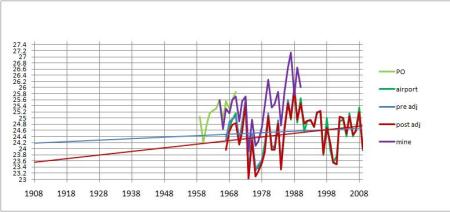If you want to study Political Science, you should enrol in a course at University.
Or, for a simple practical introduction, you could look at the March 15 announcement from the CSIRO and Bureau of Meteorology.
Read this through, then come back:
http://www.bom.gov.au/announcements/media_releases/ho/20100315a.pdf
Temperature will take longer to look at, but Australians are probably more affected by rainfall or lack of it than temperature change, so I’ll tackle that first. The validity of the announcement’s section on rainfall can be tested quickly and easily, from the BOM website
http://www.bom.gov.au/cgi-bin/climate/change/trendmaps.cgi
and
http://www.bom.gov.au/cgi-bin/climate/change/timeseries.cgi
This is what CSIRO and BOM state:
“2. Rainfall
While total rainfall on the Australian continent has been relatively stable, the geographic distribution of rainfall has changed significantly over the past 50 years. Rainfall decreased in south-west and south-east Australia, including all the major population centres, during the same period.”
Now this is technically correct, but it is also less than honest. Australia has rainfall records going back in some places to the 1870s. BOM’s charts and graphs are reliable apparently from 1900. Why not show these? Because they do NOT support the implication that Global Warming is causing much of Australia to become drier.
This is the the trend map from 1960-2009:

But compare with the trend map from 1900-2009!
Note the much debated Murray-Darling Basin, the food bowl of Australia, is wetter, in some parts much wetter, than 110 years ago.
Here are time series graphs of rainfall
Southern Australia
Northern Australia
South West Australia
Yes, South West of WA is getting drier.
Not the first time that BOM got it wrong: the Seasonal Outlooks from November, December, and January were spectacularly so.
But the document is less science than political advocay. This last week there have been a series of daily alarming reports on global warming in Australia.
This was the first.
The ordinary Australian citizen has a robust attitude to politicians: distrust.
When scientists are linked with a political position, or become advocates; or when politicians such as Mr Rudd, Senator Wong, Barack Obama, or Al Gore, make scientific pronouncements, the distinction between the science and the politics becomes blurred.
The danger for scientists is that they will become tarred with the same brush. Science in general will be the loser.
So after this latest announcement from CSIRO and BOM, who otherwise do a magnificent job, the ordinary Australian citizen could be excused for saying, in bold, capital letters:
WE DON’T BELIEVE YOU!






























